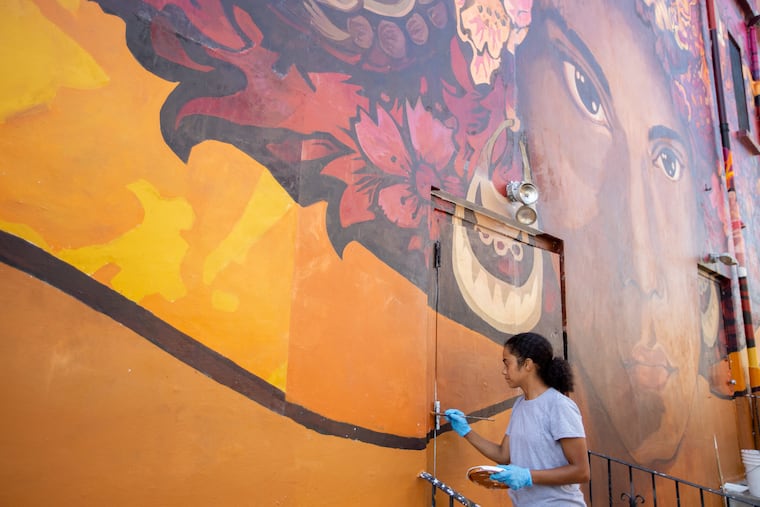A new mural in Philly’s El Barrio reflects connection to U.S.-Mexico border crisis
The mural, called “Sanctuary City, Sanctuary Neighborhood,” is political, says one of its artists.

On the rear wall of the Providence Center on Orkney Street, hundreds of migrants with weary faces are walking along the Southern border. When they turn the corner to Huntingdon Street they will be met with a blossoming Afro-Boricua woman, her hair a glorious composition of pictographs, skulls, candles, corn and deities of the Yoruba religion.
These are the symbols that mural artists Betsy Casañas and Ian Pierce have chosen as a way to pull the immigration crisis at the U.S.-Mexico border closer to Philadelphia. Despite there being more than 1,800 miles from here to the border crossing, processing centers and detainees in McAllen and El Paso, Texas, the 3,000-square-foot mural in North Philadelphia’s Puerto Rican barrio calls viewers to reflect on Philly’s immigrant communities, how Philly welcomes them as a sanctuary city, and how new South and Central American populations are joining parts of longtime Caribbean neighborhoods such as Fairhill and Hunting Park.
The mural, called “Sanctuary City, Sanctuary Neighborhood,” is political, said Ian Pierce, a Dallas-born Chilean artist, who promotes equity, cultural diversity and social justice with his work. This is Pierce’s second mural in Philadelphia, after he created “Families Belong Together” in Kensington last year. He knows that people from Latin American countries such as Chile look at the current U.S. government and immigration crisis with “great concern.”
“We are in a very complex political situation, and it’s necessary to talk about it, face it, and make sure that we create understanding,” said Pierce, 39, who, with Casañas, was commissioned by the Mural Arts Philadelphia program to create this project at Providence, the former home of Taller Puertorriqueño.
The mural — it covers the entirety of Fairhill’s Providence Center — was designed, approved, painted and installed in six weeks, a process that also included a listening session with other local artists, community leaders and North Philadelphia residents, which helped frame the concept of the project.
The artists worked with art students from the Mural Arts’ restorative juvenile program, the Guild, as well as young leaders with the Providence Center’s WorkReady program, by using the parachute cloth technique: The design is painted on slices of fabric that get glued to the wall.
Nestor Croquer, 18, a young Venezuelan volunteer at the Providence Center, said it’s exciting to see how it all comes together.
“In the beginning, no one really knows what it’s going to look like," he said. "But once it’s installed, it starts to take pretty good shape.”
This piece joins more than 4,000 indoor and outdoor murals in the city, according to Jane Golden, executive director for Mural Arts Philadelphia. This immigration-themed one, resonates with national and local audiences, she said.
“We have the unique capacity to tell the human struggle, to educate and inspire people through art," she said, "and these are times when we can, more than ever, use it to tell complex multidimensional stories.”
Coincidentally, migration patterns at the Southern border are being reflected here, according to Councilwoman María Quiñones-Sánchez, whose district includes Kensington, Fairhill, Hunting Park, and parts of Frankford and Ludlow.
Although she didn’t supply numbers, she has witnessed Mexican and Central American residents moving from South Philadelphia neighborhoods into her district, something that’s become more evident as her office conducts pop-up registrations for Philadelphia’s municipal ID, an alternative photo identification.
She attributes the move to high rents in South Philadelphia.
Casañas, 44, who is Puerto Rican, said that bringing the immigration-themed mural to the community delivers a stronger sense of sanctuary to the neighborhood.
“The idea of bringing it to the community is to make sure that we bring light to what’s happening in the Mexican border and show other folks who may not be informed.”
Mural Arts Philadelphia invested about $35,000 from private and city funding for community-based and restoration projects in this mural, which was dedicated Tuesday.
Staff writer Lucia Geng contributed to this article.